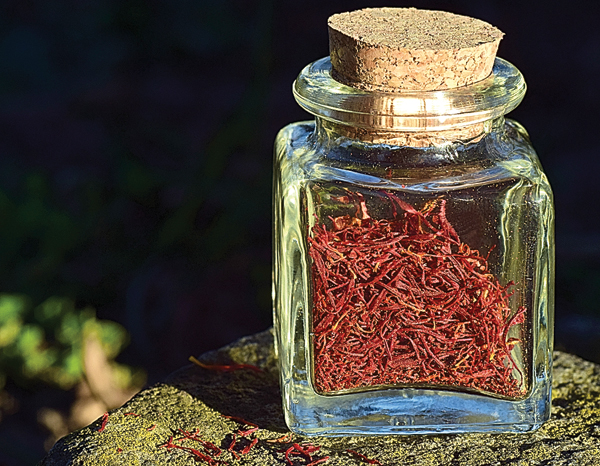
Melondy Reynolds Phillips
Staff Writer
I have roots in West Virginia, but I did not grow up here. In 2021, I was excited to be able to finally make the move “back home.”
Before moving, however, there was a lot of work to do. Because of my love for plants and herbs, one of the first things I did before listing our old home for sale, was to dig up certain plants. One of those was my saffron. I dug up the corms in the spring; they are supposed to be transplanted in the fall. With me working out of town at the time and my husband back and forth between our new home and the one we were preparing to sell, the corms just sat in an open tray drying out. It wasn’t until late fall 2021, after the time they would have come up, that I was able to plant them. To my surprise, they produced green leaves and a few flowers within only a couple of weeks. In the fall of 2022, there were several flowers to harvest from. As poorly as I had treated them and moving them from Zone 7 to Zone 5, they are doing very well and are a colorful late fall addition to the yard.
Saffron (Crocus sativus) grows from a bulb-like corm. Its thin bright green leaves resemble chives in appearance. Growth is dormant during the summer months and the leaves begin emerging in the fall. Lavender flowers, each containing three reddish orange threadlike stigmas, start to appear shortly after the leaves emerge. It may take one to three years after planting the corms before flowers produce.
Saffron threads need to be hand-harvested each morning during the short, two to three weeks of blooming. Each flower opens for only one or two days before dying. Because of this time consuming and labor intensive harvesting process, saffron is considered the world’s most expensive spice. The green leaves will remain green, even under snow, until spring, when its dormancy period begins.

Saffron contains volatile oil composed of terpenes, caretenoids, crocin and vitamins B1 and B2. According to MedicalNews Today.com/articles/ 327017, What are the health benefits of saffron? by Jon Johnson, November 15, 2019, benefits of saffron may include: protecting damage to the nervous system and oxidative damage to the brain. Other benefits may include mood improvement, a positive effect on libido, easing symptoms of PMS, and may curb appetite to help promote weight loss.
The National Library of Medicine published a research study in spring 2016 on saffron’s effect on patients with age-related macular degeneration (AMD). In this study, www.ncbi.nlm.nih.gov/pmc/ar ticles/PMC5342880/, by Farabi Eye Research Center and Psychiatric Research Center, the findings reported “results are in agreement with other studies… that showed a significant improvement in retinal function in association with antioxidants supplementation” and “patients in the saffron group frequently gave subjective reports of better vision as well as reports of increased general well being.” The study also stated, “In conclusion, daily supplementation with 30 mg of saffron for six months was associated with statistically significant changes in macular OCT (optical coherence tomography) and ERG (electroretinography) para- meters in patients with both dry and wet AMD.”
Traditionally saffron has been used for cough, insomnia, atherosclerosis, depression, anti-tumor, anti-inflammatory, memory improvement and much more.
Because of the high cost of saffron, many disreputable sellers combine other ingredients with it or completely replace saffron with an inferior product to increase profits. SUR in English website posted an article on Monday, 4 April 2022, www.sur inenglish.com/spain/gang-arrested-selling-20220404 173855-nt.html, about how 11 members of a criminal gang were arrested for selling fake saffron powder made from gardenia. More than 400 pounds worth over $750,000 was seized. This is not an isolated instance. Other herbs, such as safflower and marigolds, may look like saffron, but they do not contain the important nutrients that make saffron so sought after.
Ways to ensure you are getting the real stuff is to either buy locally from a grower you know and trust or to grow this easily cared for herb yourself.
Saffron likes full sun to partial shade. The corms are planted in the fall. After planting, keep the beds well mulched and free of weeds, even during the dormant period. Young crocus will produce leaves the first year but the flowers may take up to three years to start blooming. Once established, they are self-multiplying and should be divided every several years to allow room for the mature corms to produce healthy flowers. Mulching, keeping the weeds out, and daily harvesting of the threads for the short blooming period in the fall are the only care this wonderful herb really needs.
Saffron has many uses. The threads can be easily incorporated into meals, in rice, pasta and soups. Placing a few threads into a mug and covering them with hot water makes a delightful tea. For those who do not like the flavor of saffron but want the nutrients from it, a few threads can be placed into an empty capsule and taken like a pill. Empty capsules are easily assembled and many can be made at one time and stored for later use.
Saffron is considered generally safe for daily use; however, caution should be taken if allergic to other plants in the same family of Iridaceae. Also, if pregnant, always seek professional advice before trying any kind of supplements.


